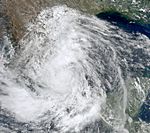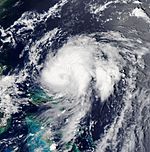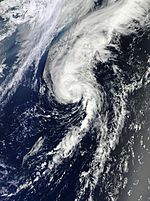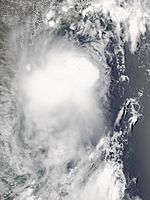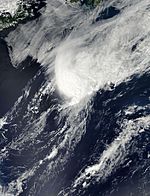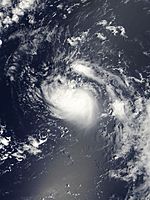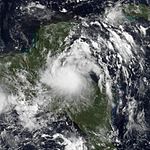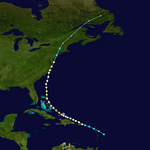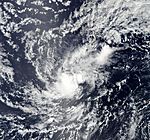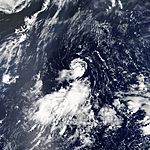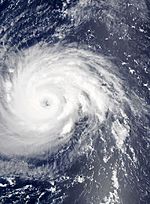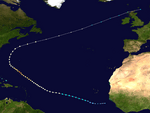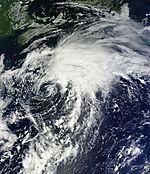2011 Atlantic hurricane season facts for kids
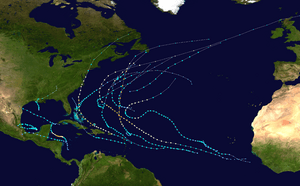 |
|
| Season summary map | |
| First storm formed | June 29, 2011 |
|---|---|
| Last storm dissipated | November 12, 2011 |
| Strongest storm | Ophelia – 940 mbar (hPa) (27.77 inHg), 140 mph (220 km/h) |
| Total depressions | 20 |
| Total storms | 19 |
| Hurricanes | 7 |
| Major hurricanes (Cat. 3+) | 4 |
| Total fatalities | 118 total |
| Total damage | > $10.6 billion (2011 USD) |
| Atlantic hurricane seasons 2009, 2010, 2011, 2012, 2013 |
|
The 2011 Atlantic hurricane season was a very busy time for storms in the Atlantic Ocean. It lasted from June 1 to November 30, 2011. This season had more storms than average. Many tropical cyclones, which are like big spinning storms, formed in the Atlantic basin.
The season began when Tropical Storm Arlene formed on June 29 in the Gulf of Mexico. It hit land in Veracruz, Mexico. Arlene caused 25 deaths and about $223 million in damage. After Arlene faded away, many other tropical storms started to form. Most of these storms grew from a frontal boundary, which is where different air masses meet. This season was special because the first eight named storms did not become hurricanes.
This record changed when Hurricane Irene formed in late August. Irene was the first "major hurricane" of the season. A major hurricane is a very strong storm, Category 3 or higher on the Saffir–Simpson Hurricane Scale. After Irene, Hurricane Katia became the second major hurricane. Out of seventeen tropical storms, only four became hurricanes. Later, Hurricane Rina also formed. Between September 7 and 9, three tropical cyclones were active at the same time: Katia, Maria, and Nate. This busy period led the Climate Prediction Center to announce a La Niña Advisory.
Contents
- Season Summary
- Storms of 2011
- Tropical Storm Arlene
- Tropical Storm Bret
- Tropical Storm Cindy
- Tropical Storm Don
- Tropical Storm Emily
- Tropical Storm Franklin
- Tropical Storm Gert
- Tropical Storm Harvey
- Hurricane Irene
- Tropical Depression Ten
- Tropical Storm Jose
- Hurricane Katia
- Unnamed Tropical Storm
- Tropical Storm Lee
- Hurricane Maria
- Hurricane Nate
- Hurricane Ophelia
- Hurricane Philippe
- Hurricane Rina
- Tropical Storm Sean
- Storm Names
- Images for kids
- See also
Season Summary

Storms of 2011
Tropical Storm Arlene
| Tropical storm (SSHS) | |||
|---|---|---|---|
|
|||
| Duration | June 28 – July 1 | ||
| Intensity | 65 mph (100 km/h) (1-min), 993 mbar (hPa) | ||
Tropical Storm Arlene started from a tropical wave. This is a low-pressure area that moves through the tropics. It brought heavy rain and floods to Central America. Three people died because of the floods. On June 27, the storm system moved over the Yucatán Peninsula and into the Bay of Campeche. It grew stronger over warm water. It was named Arlene on June 29. Arlene hit Cabo Rojo with winds of 65 mph. It then weakened and disappeared on July 1. In total, 22 people died. Arlene caused over $207.4 million in damage.
Tropical Storm Bret
| Tropical storm (SSHS) | |||
|---|---|---|---|
|
|||
| Duration | July 17 – July 22 | ||
| Intensity | 70 mph (110 km/h) (1-min), 995 mbar (hPa) | ||
Tropical Storm Bret formed from a cold front near Florida. On July 16, a low-pressure area developed north of the Bahamas. It started to get stronger. The storm became tropical depression number 2 near Great Abaco Island. Within three hours, it was named Bret. Bret grew stronger as it moved northeast. However, it began to weaken because of wind shear. Wind shear is when winds blow in different directions or at different speeds at different heights. Bret disappeared on July 22 with winds of 65 mph.
Tropical Storm Cindy
| Tropical storm (SSHS) | |||
|---|---|---|---|
|
|||
| Duration | July 20 – July 22 | ||
| Intensity | 70 mph (110 km/h) (1-min), 994 mbar (hPa) | ||
Tropical Storm Cindy formed on July 20. It started as a tropical depression east of Bermuda. It lasted only two days and did not hit land.
Tropical Storm Don
| Tropical storm (SSHS) | |||
|---|---|---|---|
|
|||
| Duration | July 27 – July 30 | ||
| Intensity | 50 mph (85 km/h) (1-min), 997 mbar (hPa) | ||
Tropical Storm Don formed on July 27. It hit land near Galveston, Texas, but it was already weakening. The storm did not bring much rain to help with the drought in Texas. It dropped less than an inch of rain.
Tropical Storm Emily
| Tropical storm (SSHS) | |||
|---|---|---|---|
|
|||
| Duration | August 2 – August 7 | ||
| Intensity | 50 mph (85 km/h) (1-min), 1003 mbar (hPa) | ||
Tropical Storm Emily formed on August 1. It hit Haiti as a remnant low. A remnant low is what's left of a storm after it loses its tropical features. Emily then got stronger as it moved through the Bahamas. After leaving the Bahamas, it started to weaken and disappear.
Tropical Storm Franklin
| Tropical storm (SSHS) | |||
|---|---|---|---|
|
|||
| Duration | August 12 – August 13 | ||
| Intensity | 45 mph (75 km/h) (1-min), 1004 mbar (hPa) | ||
Tropical Storm Franklin formed on August 12. It did not hit land. Bermuda received some rain from the storm as it passed nearby. Franklin began to disappear after it moved away from Bermuda.
Tropical Storm Gert
| Tropical storm (SSHS) | |||
|---|---|---|---|
|
|||
| Duration | August 13 – August 16 | ||
| Intensity | 65 mph (100 km/h) (1-min), 1000 mbar (hPa) | ||
Tropical Storm Gert formed on August 14. It did not make landfall. As Gert got closer to Bermuda, a small eye-like feature appeared on radar. This is the calm center of a storm. At this time, Gert reached its strongest point with winds of 60 mph.
Gert passed about 90 mi (150 km) east of Bermuda. It brought light rain and winds up to 25 mph to the islands. By August 16, the storm's clouds and thunderstorms, called convection, had mostly disappeared. Gert then became a post-tropical cyclone over the Atlantic. This means it lost its tropical storm characteristics.
Tropical Storm Harvey
| Tropical storm (SSHS) | |||
|---|---|---|---|
|
|||
| Duration | August 19 – August 22 | ||
| Intensity | 65 mph (100 km/h) (1-min), 994 mbar (hPa) | ||
Tropical Storm Harvey formed on August 18. It hit land in Belize. Harvey became a tropical storm on August 19. It was expected to become a hurricane before hitting land, but it only got a little stronger. Harvey then set a record for the Atlantic. It was the eighth tropical storm in a row that did not become a hurricane. Harvey weakened to a depression. It briefly became a tropical storm again in the Bay of Campeche before disappearing on August 22.
Hurricane Irene
| Category 3 hurricane (SSHS) | |||
|---|---|---|---|
|
|||
| Duration | August 21 – August 28 | ||
| Intensity | 120 mph (195 km/h) (1-min), 942 mbar (hPa) | ||
Hurricane Irene formed on August 20. It became a hurricane while passing through Puerto Rico. This made Irene the first hurricane of the season. Irene became a Category 2 hurricane before reaching the Bahamas. It then strengthened into a major hurricane, the first of the season.
Irene hit land at Cape Lookout, North Carolina. It was a Category 1 hurricane with 85 mph winds. It had a very low pressure for a Category 1 storm. It then moved northeast. After weakening to a tropical storm, Irene hit land again in New Jersey. The storm then moved north, affecting New York City and New England. In total, 56 people died in the Caribbean, 10 U.S. states, and Canada. Hurricane Irene caused $19 billion in damage, making it one of the costliest Atlantic hurricanes. Irene disappeared on August 29.
Tropical Depression Ten
| Tropical depression (SSHS) | |||
|---|---|---|---|
|
|||
| Duration | August 25 – August 26 | ||
| Intensity | 35 mph (55 km/h) (1-min), 1006 mbar (hPa) | ||
Tropical Depression Ten formed on August 25. It moved away from the coast of Africa. It then started moving northeast. The storm disappeared the very next day.
Tropical Storm Jose
| Tropical storm (SSHS) | |||
|---|---|---|---|
|
|||
| Duration | August 27 – August 28 | ||
| Intensity | 45 mph (75 km/h) (1-min), 1006 mbar (hPa) | ||
Tropical Storm Jose formed on August 27. Jose did not hit any land. On August 28, the tropical wave that formed Jose briefly got stronger. However, it almost disappeared again because of high wind shear. This time, the wind shear was caused by Hurricane Irene. But soon after, the tropical wave managed to become Tropical Storm Jose, just west of Bermuda. Jose then moved slowly north-northeast. It only lasted 27 hours, disappearing on August 29.
Hurricane Katia
| Category 4 hurricane (SSHS) | |||
|---|---|---|---|
|
|||
| Duration | August 29 – September 10 | ||
| Intensity | 140 mph (220 km/h) (1-min), 942 mbar (hPa) | ||
The eleventh named storm of the season formed south of the Cape Verde Islands on August 29. It became a tropical storm on August 30 and was named Katia.
Hurricane Katia became the season's second hurricane on September 1. It grew stronger until September 4, becoming a Category 2 hurricane. On September 5, it reached Category 3, making it a major hurricane. Katia then strengthened even more, becoming a Category 4 hurricane on September 5. It weakened to a Category 1 storm by the next day. It stayed at that strength even as it became "extra-tropical," meaning it lost its warm core. Katia was watched closely because it could affect the east coast of the United States and Canada. Warnings were issued for Northern Ireland and Scotland for the remains of Katia. Its remnants hit the UK and Ireland on September 11 and 12, causing one death. They also caused power outages as far east as Saint Petersburg.
Unnamed Tropical Storm
| Tropical storm (SSHS) | |||
|---|---|---|---|
|
|||
| Duration | September 1 – September 2 | ||
| Intensity | 45 mph (75 km/h) (1-min), 1002 mbar (hPa) | ||
The Unnamed Tropical Storm formed on September 1 east of Boston, Massachusetts. It started as a tropical depression. The storm continued to get stronger and became a tropical storm later that day. It lost all of its tropical features on September 2.
Tropical Storm Lee
Tropical Storm Lee formed on September 1. It moved into the Gulf of Mexico. It hit land in Lafayette, Louisiana, as a small tropical storm. It then moved northeast before disappearing on September 5.
Hurricane Maria
Hurricane Maria formed on September 6. It moved close to Puerto Rico, bringing a lot of rain to the island. Maria became a Category 1 hurricane before it hit land in Newfoundland. Maria then disappeared on September 16.
Hurricane Nate
Hurricane Nate formed on September 7. Nate hit land near the Mexican coastline. It disappeared on September 12.
Hurricane Ophelia
Hurricane Ophelia formed on September 20. Ophelia then became a remnant low five days later. On September 27, the storm started to get stronger again. It became a Category 1 hurricane on September 30. On the same day, it became a Category 2 hurricane. The next day, the storm became a Category 3 hurricane. On October 1, the storm became a Category 4 hurricane. After that, the storm quickly weakened and lost its tropical features on October 3.
Hurricane Philippe
Tropical Storm Philippe formed on September 24. It was a tropical storm for 12 days. It then became a Category 1 hurricane on October 6. It weakened back to a tropical storm the next day. It was no longer a tropical storm on October 8.
Hurricane Rina
Hurricane Rina formed on October 23 in the Caribbean Sea. It started as a tropical depression. It quickly grew stronger and became Tropical Storm Rina just hours later. On October 24, Rina reached Category 1 hurricane status. It was still getting stronger quickly by October 25, becoming a Category 2 hurricane in the morning. It later weakened back to a Category 1 hurricane, then a tropical storm. It continued to weaken and became a tropical depression (winds of 39 mph or less) on October 28. It became post-tropical (lost its tropical features) later that day.
Tropical Storm Sean
A large area of clouds that moved off North Carolina became Tropical Storm Sean on November 8. It had winds of 50 mph. The storm continued to get stronger and reached its peak with winds of 65 mph. It disappeared on November 12 because it merged with a cold front.
Storm Names
The names used for storms in 2011 were:
|
|
|
Name Retirement
In the spring of 2012, the WMO (World Meteorological Organization) decided to "retire" the name "Irene." This means the name "Irene" will never be used again for an Atlantic storm. The name "Irma" was chosen to replace it.
Images for kids
See also
 In Spanish: Temporada de huracanes en el Atlántico de 2011 para niños
In Spanish: Temporada de huracanes en el Atlántico de 2011 para niños


